
Welcome to the Plant Biology (SC/BIOL 2010.04) course website (from 1998 through 2015). This is your central source for announcements, lab and lecture information, handouts, past tests, useful links etcetera.
Announcements
11 July 2018: From time to time, additions will be made to the Plants in the News section.
Miscellanea
23 March 2015 (miscellanea): Tree buds
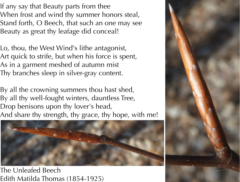
With the cold spring, beech buds remain dormant.
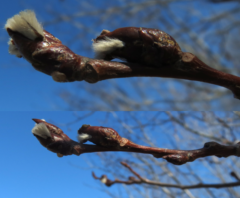
On southern exposures, Populus flower buds are starting to emerge
23 April 2014 (miscellanea): Erythronium emerges!
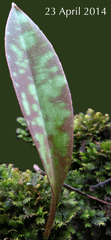
Two weeks after the silver maples bloom, trout lily (Erythronium) leaves start to emerge.

27 April 2014 Update: And four days later, larch leaves start to emerge
10 April 2014 (miscellanea): Maple flowers!
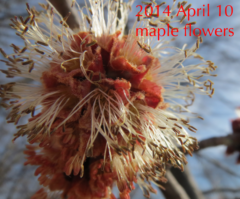
Just a few days of warm weather is all it took. Silver maple flowers are starting to fully bloom.
8 April 2014 (miscellanea): Maple flowers break bud!
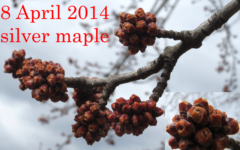
Spring is very late this year compared to the past few years. Silver maple flowers are only starting to break bud, when they are usually in full flower by now.
26 February 2014 (miscellanea): Mosquito pollinators
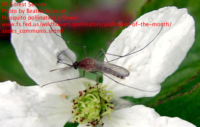
Even mosquitoes are pollinators, and are known to pollinate small northern orchids. The US Forest Service has a site devoted to pollinators of the month that describes mosquito pollinators, amongst many others.
17 February 2014 (miscellanea): C-Fern Babies!
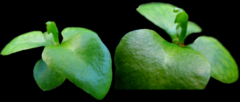
The Ceratopteris C-Ferns that we fertilized in December are now well established in the greenhouse. These will be used for science outreach: A Bring a Fern Baby Home for Mother's Day event for Science Rendezvous in May.
15 April 2013 (miscellanea): Erythronium emerges!
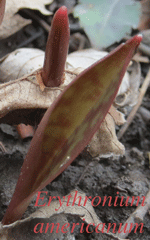
Finally, Erythronium americanum emerges in the Boyer Woodlot! It's late this year (by about 2 weeks) because of the cold spring we have had so far. The flowers will blossom in about 2-3 weeks.
6 August 2012 (miscellanea): Greenhouse Blossoms
Sometimes during the summer months, we get special blossoms in the greenhouse collection. Here is an Aloe, forming a colourful spike inflorescence during the hot days of August. Here is more about the greenhouse.
28 February 2012 (miscellanea): Spectral Sensivity of Biological Vision
In his guest lecture (Bees Rule!), Professor Zayed noted the differences in spectral sensitivity of bees and how that affects floral attraction (and the ability of spiders lurking in the blossom to entrap bees). The diagram (click on it for a larger version) compares spectral sensitivity of a variety of insects and other animals (including humans). Insects are notable for their UV sensitivity. The diagram comes from a book by David Lee entitled Nature's Palette. The science of plant color, a fascinating read in its own right.
20 april 2011 (miscellanea): Trillium grandiflorum flowers are starting to emerge (Spring Is Here!).
Trilliums are a favorite spring flower. These are the first I've seen in Boyer Woodlot. Others will emerge in the next few weeks. They are a bit later than last year, due to the relatively cold spring.
7 July 2011 Update: On 5 May, we captured a photo of a bee pollinating a Trillium flower, that Brock Harpur and Professor Amro Zayed identified as Halictus, a sweat bee. You can see Halictus and other bees in action on Amro's Bee Gallery website.
20 april 2011 (miscellanea): Populus catkins starting to set seed (Spring Is Here!).
Poplar tree flowers are nowhere near as showy as Trilliums, but they are much faster: Already beginning to set seed before Trillium flowers emerge. Populus flowers are one of the first harbingers of spring. Taken at the western edge of Boyer Woodlot.
3 april 2011 (miscellanea): Acer saccharinum flowers have blossomed (Is Spring Officially Here?).
Silver maples have unisexual flowers. The females and males may occur on the same tree (monoecious) or on separate trees (dioecious).
18 march 2011 (miscellanea): Here is a link to a short (and reasonably 'readable') mini-review of self-incompatibility responses in plants.
The mini-review should aid understanding of the general division between gametophytic and sporophytic incompatibility, but be warned that recent research has revealed even greater complexities on the mechanisms underlying incompatibility responses in pollination.
16 february 2011 (miscellanea): As promised in lecture, here is a picture of a Drosera spp. (sundew).
Having captured an insect, the leaf is bending inwards to digest it. The photograph was taken by Noah Elhardt, who provides other beautiful examples in the Wikipedia Commons.
Carnivory is not so uncommon in plants. One example that is being highlighted in the popular science press is Ultricularia spp., which trap crustaceans underwater. Here is a link to the paper and to some cool time lapse movies.
13 february 2011 (miscellanea): Jessica Budke's Moss Plants and More blogspot
highlighted a Callifornia Academy of Sciences
video featuring
the bryologist Jim Shevock. He talks about the remarkable ability of mosses to survive dessication. It shouldn't be a surprise to you
to discover that sex is a big deal for a moss (or, more scientifically, the requirement for water).
11 february 2011 (miscellanea): The scientific evidence for the invasion of land by plants depends upon the fossil record. With each new discovery the date of the invasion gets pushed back.
The most 'recent' discovery is of cryptospores of liverworts, dated 470 million years ago
1 february 2011 (miscellanea): Fungal growth is even more dramatic when viewed time lapse.
Here is a movie of Neurospora crassa wildtype, showing growth at the colony edge, and the development of the ramifying mycelial network behind the colony edge (click on the image for the movie [.mov 5.5 MB]).
21 january 2011 (miscellanea): Diatom motility is a fascinating research topic, an example of how ameboidal movement can be harnessed by a cell encased in glass (well, silica).
After discovering this surprising phenomenon when assessing soil samples for Health and Safety, I collected some soil from a drainage seep on campus, and made a movie of a diatom glider (click on the image for the movie [.mov 2.8 MB].
10 january 2011 (miscellanea): Bacterial motility is a fascinating aspect of the diversity of life, and an example of a nanomolecular motor that continues to be intensively studied.
One 'original' explanation for bacterial motility proposed (in fun!) by the Nobel Laureate EM Purcell was a flagellar man turning a crank inside the bacteria (Click on the photo for a version of his original drawing). Of course, things are more complicated, involving a stator and rotor system quite similar to an electrical motor
03 january 2011 (miscellanea): Lynn Margulis will speak at York University (31 January).
Lynn Margulis is famous for developing the revolutionary concept of endosymbiosis to explain the appearence of eucaryotic cells from bacterial progenitors (Symbiosis in Cell Evolution). Acceptance of her novel theory more than 30 years ago was by no means without controversies! It's exciting to have her speak here at York University. Click on the photo for more information
Update: Lynn Margulis gave a fascinating talk. She started with a discussion of the Gaia Hypothesis developed by James Lovelock. The Gaia Hypothesis emphasizes the role of the biota in regulating environmental conditions on earth. Terra-forming by photosynthetic organisms that elevated oxygen to unprecendented levels is only part of the hypothesis in toto. Then, she talked about new developments in the endosymbiosis theory: Googling endosymbiogenesis will give you a flavour.
Update: Lynn Margulis passed away 22 November 2011 at the age of 73. She was a highly respected biologist who opened new vistas of biological discovery with her endosymbiotic theory [NYT obituary].
01 january 2011 (miscellanea): In the first lectures, we will be exploring the marvel of photosynthesis.
John McPhee, in a book entitled Annals of a Former World describes the remarkable impact of photosynthesis in Geological Time: An explosive increase in atmospheric oxygen that oxidized iron to insoluble ferrics 2400 million years ago, now mined and surrounding us in the form of cars, trains and other iron artefacts of the Industrial Age.
But photosynthesis is not just about the very old. Scientists in Toronto recently discovered that photons in the light harvesting apparatus are entangled. That is, the excited states caused by light absorption in two separate locations in the light harvesting apparatus are not separable, a deep consequence of Quantum Physics.
Go to Archives
